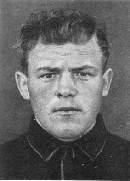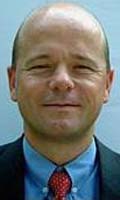    Etymology: Borreby is the name of a Danish village and archaeological site where large brachycranial skulls of the Upper Paleolithic were unearthed.
-
Blond Brachycephal, The (Arbo; includes all blond
brachycephals) Origins: Mostly unreduced, brachycephalized, and depigmented Upper Paleolithic survivor of Cro-Magnoid stock, related to Dalo-Falid and Brünn on one hand and Alpinid on the other. The affiliation is essentially with the former, but a partial process of alpinization establishes an evolutionary relation to the latter. The southern and south-western border with fully alpinized central Europeans is blurry, and has resulted in a number of local intermediate types, such as the Belgian "Walloons type". Modern Borrebys are derived, historically, from the old northwestern European coastal fishing population. In many places, such as the Norwegian coastal district of Jæren, Borrebys seem to have been among the first humans to settle permanently, during the late Mesolithic. In modern times the Borreby type is found nowhere as a true population,
except perhaps in Jæren and on the island of Fehmarn, off the German coast,
where it exists in relative purity. Elsewhere it is strongly diluted with other
elements. Description: The Borreby type is large-bodied and large-headed, and lateral in most features. It is tall to very tall (but generally less so than Dalo-Falids), muscular, and usually quite heavy, with a tendency towards chubbiness. Paedomorphous features are particularly common in females, who are often buxom. The head form is brachycephalic (c.i. typically 82-84), and the occiput is nearly vertical and often slightly flattened. The temporal bones are weakly curved, but parietal tuberosities are usually strong. The forehead is broad, only slightly curved, quite high, and usually of but little slope. The Borreby face is typically square in appearance, due mostly to the great mandibular width and the prominence of the frontal and parietal tuberosities, but rounded, more Alpinoid-shaped faces are also common, especially among females. The face is usually short, broad, and somewhat flattish, with a strongly ortognathous profile. The jaw is rather deep, and the browridges of moderate size. The nose profile is straight in about 5/6 of cases, and concave in the remainder; convexity is not common. The nose form is meso- to leptorrhine.
The hair is typically golden blond to light or medium brown. The total Borreby hair shade
range runs from ash blond to dark brown, and the latter category accounts for some 30%
of cases. Blue eyes are in the majority, but mixed and grayish blue are also common. Illustrations:
Celebrity examples:
(USA; German descent) (The Netherlands) (USA; Danish descent) (USA)
(Denmark) (?) (Norway) (England)
The greatest center of Borreby concentration lies in the southern part of the Danish peninsula (Jutland), extending into northern Germany. In the midst of this zone lies the island of Fehmarn, which houses a population of exaggerated Borreby phenotype and extreme head dimensions (Fehmarner type). The Borreby is found as a major population element across the entire northern German plain, and a secondary center, which has now more or less disappeared, is located in the southwest, in the vicinity of Stuttgart. The Scandinavian extension of the Borreby population is concentrated in the coastal areas, with a notable survival in Jæren (southwestern Norway; Jæren type). Borreby types are not uncommon the southwestern parts of Sweden, in the general vicinity of Göteborg. The Borreby zone is transitional to the Alpinid zone in the southwest, and to the Baltid in the east. The former transition has given rise to an intermediate Alpine-Borreby type, the Walloons type. In the northwest, along parts of the Norwegian coast line, Borrebys are frequently mixed with Strandids, Upper Paleolithic survivors of a more fully alpinized and considerably darker Cro-Magnoid strain.Special subtypes: - "Fehmarner type" - "Jæren type" Related or similar types:
|













